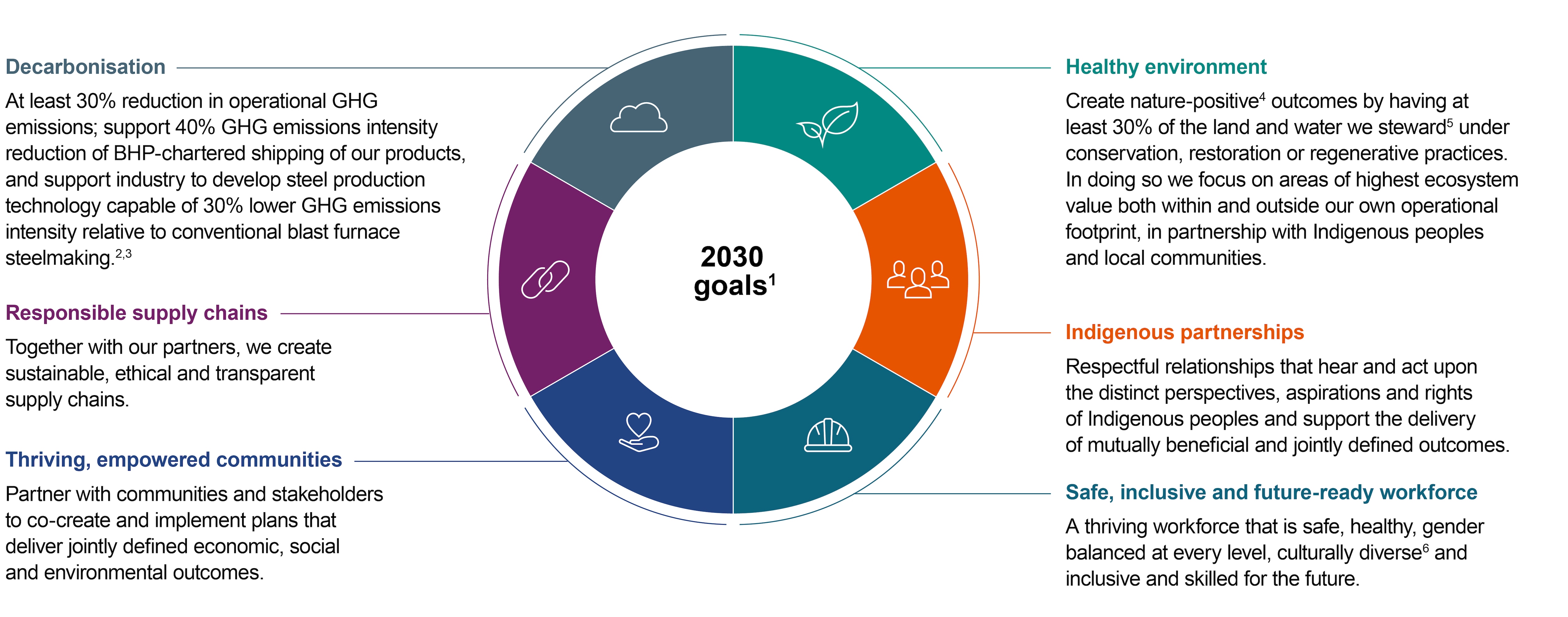We know our stakeholders and partners are increasingly focused on our sustainability performance and use it as a key determinant in assessing BHP and our industry. We strive to continuously improve and exceed these expectations.
2030 goals1
Our management of sustainability helps generate social value.

Footnotes:
- In setting BHP's 2030 goals, we had regard to existing public sustainability frameworks, including the UN Sustainable Development Goals, the Paris Agreement, Convention on Biological Diversity, The Global Business Collaboration for Better Workplace Mental Health and the UN Declaration of the Rights of Indigenous Peoples. Our pillars map to the UN Sustainable Development Goals as follows: Decarbonisation – Goal 13; Healthy environment – Goals 6, 14, 15; Indigenous partnerships – Goals 8, 10, 17; Safe, inclusive and future-ready workforce – Goals 3, 5, 10; Thriving, empowered communities – Goals 3, 4, 6, 7, 8, 9, 10, 11, 16 and Responsible supply chains – Goals 10, 12, 16, 17.
- With widespread adoption expected post 2030.
- For the definition of the terms used to express these positions, including ‘target’, ‘goal’, ‘net zero’, ‘carbon neutral’ and ‘operational GHG emissions’ refer to the BHP Annual Report 2025, Additional information 10.4 – Other terms. For more information on the essential definitions, assumptions and adjustments for our targets and goals refer to Climate-related metrics, targets and goals in the BHP Annual Report 2025, Operating and Financial Review 9.8 – Climate change.
- Nature-positive is defined by the Taskforce on Nature-related Financial Disclosures Glossary version 1.0 as ‘A high-level goal and concept describing a future state of nature (e.g. biodiversity, ecosystem services and natural capital) which is greater than the current state’. We understand it to include land and water management practices that halt and reverse nature loss – that is, supporting healthy, functioning ecosystems. We are monitoring the evolving external nature landscape, including developments in nature frameworks, standards and methodologies and in definition of the global nature ambition.
- Excluding areas we hold under greenfield exploration licences (or equivalent tenements), which are outside the area of influence of our existing mine operations. 30 per cent will be calculated based on the areas of land and water that we steward at the end of FY2030. For more information refer to the BHP ESG Standards and Databook 2025.
- Cultural diversity in our workforce will be measured based on our substantive progress towards reflecting the cultural diversity of the societies where we operate.
We also believe sustainability includes playing an appropriate role in addressing global issues, such as climate change, supporting and respecting human rights and advocating for social change, such as by supporting the rights of Indigenous peoples.
The resources life cycle of exploration and production through to rehabilitation and closure requires us to operate our assets over many decades. This means the long-term health of BHP’s business is directly dependent on the long-term health of society and the natural environment.
Sustainability case studies, organisational boundary, definitions and disclaimers, and downloads
Prior year versions of some of the listed documents are available on the Past reports page.-
BHP Annual Report 2025
pdf
17068205

-
Sustainability reporting organisational boundary, definitions and disclaimers
pdf
170075

-
Límite organizativo de los informes de sostenibilidad, definiciones y descargos de responsabilidad
pdf
234993

-
BHP ESG Standards and Databook 2025
xlsx
2541694

-
BHP Group Modern Slavery Statement 2025
pdf
7308735

-
BHP GHG Emissions Calculation Methodology 2025
pdf
1124687

-
BHP Climate Transition Action Plan 2024, subject to updates of certain aspects of our assumptions and plans in the BHP Annual Report 2025, Operating and Financial Review 9.8 – Climate change
pdf
8480121

-
Global Industry Standard on Tailings Management - Public Disclosure 2025
pdf
25537144

-
Tailings Storage Facility Policy Statement 2023
pdf
73457

-
Case studies

Get the latest BHP news alerts, straight to your inbox
Get BHP news first. Stay in touch with our latest updates, investor news and media releases.

















